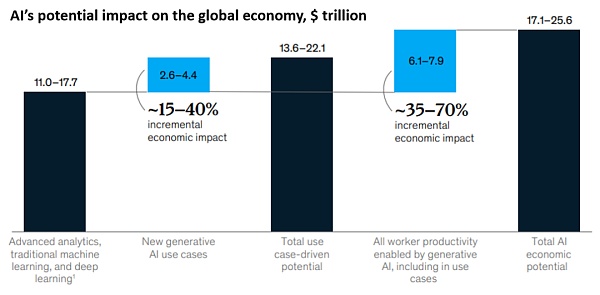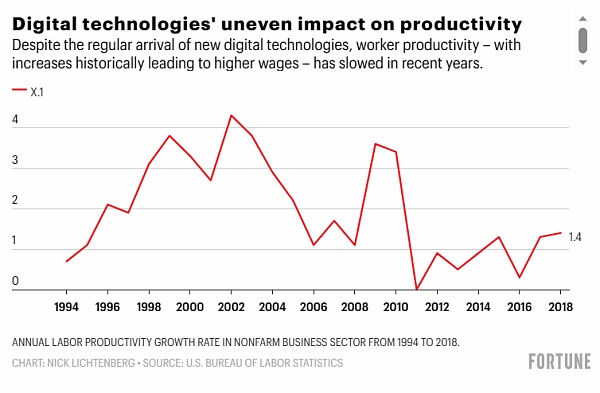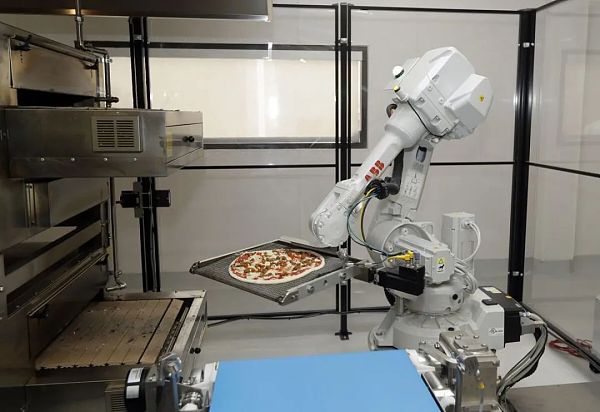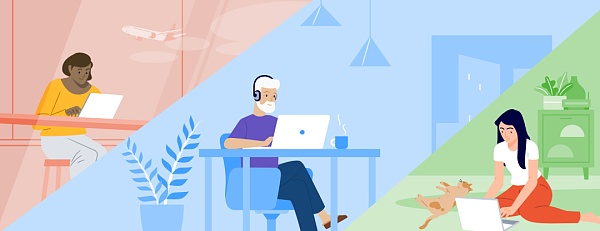How will AI affect future work? A deep interpretation from the perspective of the productivity paradox.
The impact of AI on future work: an analysis from the perspective of the productivity paradox.The hype around artificial intelligence has caught people’s attention not only because of its algorithms’ startling ability to mimic human intelligence but also because these algorithms are likely to replace many people’s jobs. The economic and social consequences could be dramatic.
One way this economic transition is happening is through work. A widely circulated study by Goldman Sachs estimates that about two-thirds of current professions could be affected in the next decade, with as much as one-quarter to one-half of what people are now doing in their jobs being taken over by algorithms, potentially affecting up to three billion jobs worldwide.
Consultancy firm McKinsey published their own research predicting that the AI-driven global economy will add $4.4 trillion annually.

- DeFi “Janitor” Poop: Recycling User’s Worthless Tokens to Achieve “Only Upward Movement”
- Refuting the Claim that MOVE Blockchain is a Consortium Chain from 12 Perspectives
- Can Web3 games escape the SEC’s sword dance?
These huge numbers are thought-provoking, but how reliable are these predictions?
I lead a research project called “Digital Planet” that studies the impact of digital technology on people’s lives and livelihoods around the world, and how that impact changes over time.
By studying how digital technology waves such as personal computers and the internet have affected workers, we can gain insights into the potential impact of artificial intelligence in the next several years. But if the future of work can serve as a guide, we may need to be mentally prepared ahead of time.
01. The IT revolution and the productivity paradox
The key indicator of technology’s impact on the economy is growth in worker productivity – defined as how much output an employee can produce per hour of work. This seemingly dry statistic is important to every worker, as it is directly related to how much compensation a worker can expect to earn per hour of work. In other words, higher productivity is expected to lead to higher wages.
AI products can generate written, graphic, and audio content or software programs with minimal human involvement. Industries such as advertising, entertainment, creativity, and analytics may be the first to feel the impact. Professionals in these fields may be concerned that companies will use AI to replace the work they once did, but economists believe that using this technology has great potential to increase productivity for the entire workforce.

Goldman Sachs research predicts that productivity will increase by 1.5% annually due to the adoption of generative AI, almost twice the rate between 2010 and 2018. McKinsey is even more optimistic, stating that this technology and other forms of automation will usher in the “next frontier of productivity,” pushing it up to 3.3% annually by 2040.
This productivity boost will approach the growth rates of past years, which theoretically would be welcomed by economists and the working class alike.
If we look back at US productivity growth in the 20th century, from 1920 to 1970 it roared along at a rate of about 3% per year, raising real wages and living standards. Interestingly, in the 1970s and 1980s, productivity growth slowed with the introduction of computers and early digital technology.
This “productivity paradox” was famously characterized by MIT economist Bob Solow as “you can see the computer age everywhere but in the productivity statistics.”

Digital technology skeptics blame “ineffective” time spent on social media or shopping and argue that earlier changes, like the introduction of electricity or the internal combustion engine, had a greater impact on the nature of work.
Tech optimists disagree, arguing that new digital technologies take time to translate into productivity growth, as other complementary changes also need to develop simultaneously. Some also worry that productivity metrics may not fully capture the value of computers.
However, “for a while, it seems, the optimists will be proved right.” In the late 1990s, just as the World Wide Web was coming into existence, US productivity growth doubled, from a 1.5% annual rate in the previous decade to 3% in the second decade.
Despite renewed disagreements about what actually happened, further muddying the waters of whether the paradox was solved, some believe that digital technology investments eventually paid off, while others argue that management and technical innovations in certain key industries were the main driving factors.
Regardless of the explanation, the 1990s boom, as mysterious as it began, was short-lived. Thus, while companies invested heavily in computing and the internet, bringing about changes in work patterns, the extent to which the overall economy and worker wages benefited from technology remains uncertain.
02. Early 2000s: Decline, Hype, and Hope
At the turn of the 21st century, the dot-com bubble burst, but in 2007 Apple introduced the iPhone, leading to another technological revolution. Consumers flocked to purchase, and businesses began to adopt in various ways. However, labor productivity growth stagnated again in the mid-2000s, bouncing briefly during the Great Recession of 2009, but returning to a sluggish state from 2010 to 2019.
In this new period of sluggishness, technological optimists still anticipate new changes. Artificial intelligence and automation become global hot topics and are believed to change work and increase worker productivity.
In addition to traditional industrial automation, drones, and advanced robots, capital and talent are also immersed in many potential game-changing areas, such as autonomous driving, grocery store automatic checkout, and even pizza-making robots.

It is expected that artificial intelligence and automation will bring more than 2% productivity growth per year in the next decade, higher than the low point of 0.4% from 2010 to 2014.
However, before we can assess how these new technologies will affect the workplace, a new unexpected event occurred: COVID-19.
03. Pandemic Productivity Boosts and Technological Hype
Despite the severity of the pandemic, worker productivity has soared since the beginning of 2020, with global hourly output growth rates reaching 4.9%, the highest level on record.
Much of this sharp rise is attributable to technology: larger, more knowledge-intensive companies (essentially more productive ones) began adopting remote work to maintain business continuity with the support of communication technologies such as video conferencing and Slack, saving commuting time and focusing on employee welfare.

While digital technologies clearly help increase the productivity of knowledge workers, in many other industries, larger-scale automation transformations have occurred because workers must stay at home to ensure their safety and comply with epidemic prevention measures. Companies in industries ranging from meat processing to restaurants, retail, and hotels have invested in automation, such as robots and automated order processing and customer service, which has helped improve their productivity.
However, investment in the technology sector experienced a sharp decline in 2020-2021, and the hype surrounding technologies such as self-driving cars and pizza-making robots has also subsided. Other hot topics, such as the metaverse revolutionizing remote work or training, seem to have gradually faded from people’s view.
At the same time, new technologies in artificial intelligence have suddenly emerged on the stage, with more direct potential to enhance productivity and affect employment – and on a massive scale. The hype cycle for new technology has restarted.
04. Thinking about the future: Social factors in technological development
Given the many twists and turns so far, we can actually predict what problems will arise in the future. Here are four points to consider.
First, the future of work is not only about the number of workers, the technology tools they use, or the work itself. We should also consider how artificial intelligence affects workplace diversity and social inequality, which will have profound implications for economic opportunities and workplace culture.
For example, while widely adopting remote work may help promote diversity through more flexible hiring, I believe that the increasing use of artificial intelligence may have the opposite effect. Black and Latinx workers are overrepresented in the 30 occupations with the highest automation risk and underrepresented in the 30 occupations with the lowest risk.
While artificial intelligence may help workers complete their work faster, thereby increasing the wages of employees, it may result in severe losses for those whose jobs are replaced . A 2021 survey found that wage inequality was most severe in countries that had already heavily relied on robots and rapidly adopted the latest robot technology.
Secondly, as workplaces balance between online and offline after Covid, the impact on productivity and discussions around this issue will remain uncertain and constantly changing. A 2022 study showed that the work environment becomes more comfortable and remote work efficiency improves as employees work from home. However, according to another study in 2023, managers and employees hold different views on the impact of remote work on productivity, with the former believing that it will decrease productivity, while the latter believes the opposite.
Third, societal reactions to the dissemination of artificial intelligence (AI) may greatly influence its progress and ultimate outcome. Analysis shows that AI can increase employee productivity in specific jobs. For example, a 2023 study found that the introduction of AI-based dialogue assistants increases the productivity of customer service personnel by 14%. 
However, there are increasing calls to consider the most serious risks of AI and to take them seriously. In addition, it is also important to recognize that the enormous computing and environmental costs of AI may limit its development and use.
Finally, given the degree to which economists and other experts have been wrong in the past, it can be said with certainty that many of today’s predictions about the impact of AI technology on work and worker productivity will also be proven wrong.
While figures like the 3 million affected jobs or the global economy increasing by $4.4 trillion per year are eye-catching, I think people are more willing to trust them more than their actual credibility. “Affected jobs” does not necessarily mean lost jobs, it may mean an increase in jobs or even a transition to new jobs. It is best to use analysis from Goldman Sachs or McKinsey to inspire our imagination of possible scenarios for future work and workers.
In my opinion, we need to actively brainstorm and look for many factors that may affect the situation, look for early warning signals, and be prepared. The history of future work is full of surprises. Don’t be shocked if revolutionary innovations suddenly appear tomorrow.
We will continue to update Blocking; if you have any questions or suggestions, please contact us!
Was this article helpful?
93 out of 132 found this helpful
Related articles
- DeFi “cleaner” Poop: Recycle users’ worthless coins and aim to achieve “only rise and no fall”
- Can OP Stack, the competitor launched by zkSync, win the battle of L2 scaling?
- Deep | Former Harmony Employee Reveals Management Chaos Behind the Struggling Public Chain
- Can OP Stack, the competitor launched by zkSync, win the L2 scaling battle?
- Introduction to ZK Stack by Matter-Labs – Building a modular framework for ZK-powered sovereign chains
- Application of liquidity in PoS: Examples of Berachain, Tenet, and Mangate
- Inventory of 11 Celebrity Cryptocurrency Scammers: Jake Blockingul, Floyd Mayweather, John Wall…





